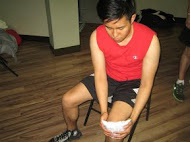A macerated wound involves softened and white deteriorating skin at the area of the injury. It happens when there is plenty of moisture trapped between the wound and the bandage and sometimes the exudate or the seepage from the wound are trapped under the bandage and wound becomes too moist. There is a high risk of fungal and bacterial infection. Always bear in mind that a macerated wound is difficult to care for and should be treated carefully.
Causes of a macerated wound
- Urinary incontinence and sweat
- Prolonged exposure to fluid or moisture.
- Side effects of chronic wounds which includes diabetic foot ulcers, bedsores, leg ulcers and fungal lesions. The fluid of these wounds has proteases which is an enzyme that breaks down protein and peptides. In addition, proteases can also breakdown healthy skin tissues.

Apply the prescribed antiseptic, anesthetic or spray on the affected wound and cover to make the wound moist but not wet.
Symptoms
- The skin around the wound is soggy and soft.
- Wrinkling of the skin around the affected wound. The skin is soft and can easily break and exposes the deep layer of the tissue.
Treatment
- Remove the old bandage around the wound and look for signs of maceration such as decaying skin or foul odor which are the indications of an infection.
- Clean the excess fluids from the affected area using sterile gauze pads. If there is significant exudate, soak it up with gauze. An exudate is a fluid rich in protein and a cellular element that goes out of the blood vessels due to the inflammation and accumulates in nearby tissues.
- If the wound is packed with pus, irrigate the area using a syringe with sterile water to cleanse out the pus.
- Apply the prescribed antiseptic, anesthetic or spray on the affected wound and cover to make the wound moist but not wet.
- Cover the wound with a clean bandage that is breathable. There are 2 types of dressing used for macerated wounds – occlusive and hydro fiber dressings. An occlusive dressing has a wax coated covering for the wound that provides air and a water-tight seal while a hydro fiber dressing is comparable to sterile gauze pad that helps absorb moisture and promotes fast healing of the condition. Some gauze pads contain iodine and prevents a wound from macerating other areas of skin. Any of these dressings is good for the condition.
- Check the macerated wound every 4 hours. Replace the soaked bandages with exudate and check the healing of the maceration. If the condition becomes worse, seek medical help immediately.
Tips
- Change bandages immediately after immersion in water to avoid contamination.
- Macerated wounds can be avoided with proper care on any type of wound, whether it is a large-sized burn covering a wide area or a cut in the finger. Excessive moisture makes the skin weak and causes it to break down easily and increases the risk for infection.
- Keep wounds dry and clean as much as possible.
Disclaimer
The material posted on this page for macerated wounds is for learning purposes only. If you want to learn to how to provide proper wound care for macerated wounds, register for a first aid course with a training provider near you.
FACT CHECK
https://en.wikipedia.org/wiki/Skin_maceration
